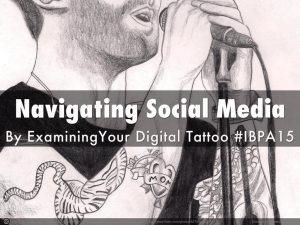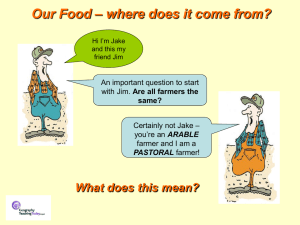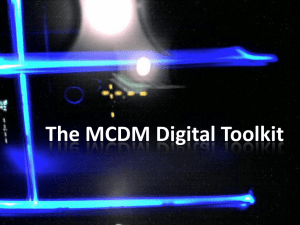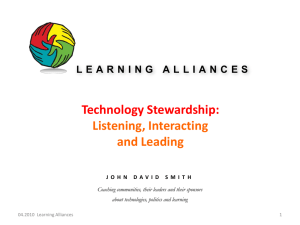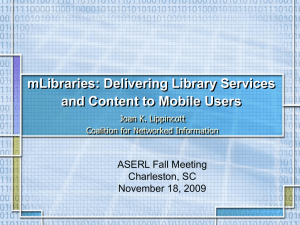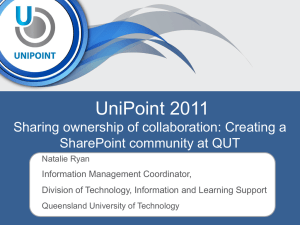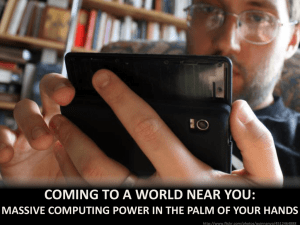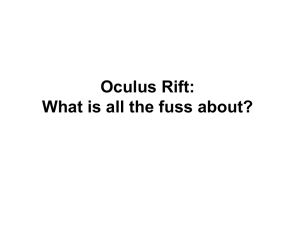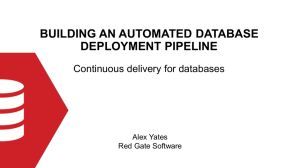creating_code_samples
advertisement
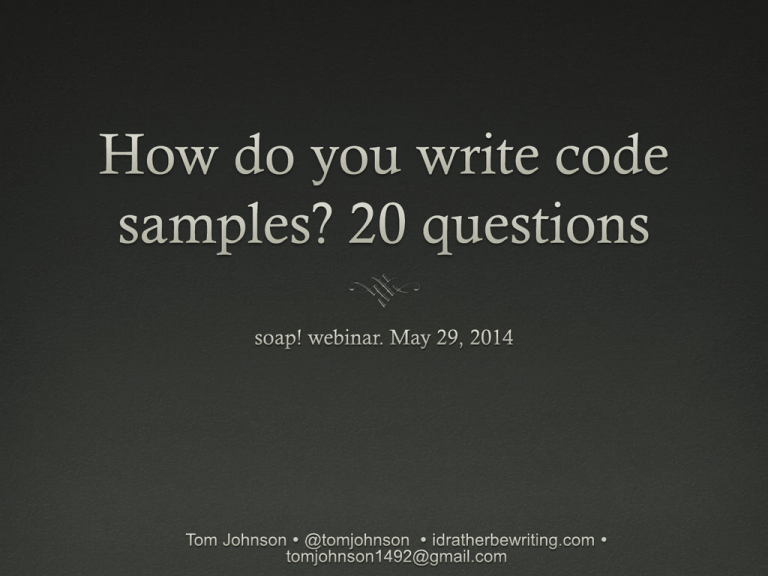
About me Started doing API/SDK documentation a little more than a year ago at a Silicon Valley startup Am still learning a ton, but enjoy this type of documentation a lot. English major, writing background First time presenting on this topic Question format 1. What are code samples? Usually supplementary material that accompanies API or SDK reference documentation (particularly SDK). Can be short or lengthy, full of comments and explanation or without any explanation at all. Great example on jquery's documentation here: http://api.jquery.com/each/ Another good example: http://docs.oracle.com/javase/tutorial/java/javaOO/ classes.html Head First Java, 2nd Edition 2. Why add code samples? Code samples are in another language. If audience speaks the language, the code communicates more clearly. Examples are much more efficient than trying to describe syntax and methods in a narrative way. Programmers often skip right to the examples to see how something is to be done. Examples illustrate how your product works in an immediate and clear way. 3. Which language should the code samples be in? "I would say at least half of web APIs do not have sample code available because once you provide it in one language, developers will want sample code in Java, C#, Ruby, Python, Objective-C, PHP, etc. which is often not practical to provide. (The beauty of web APIs is that they can be called from almost any language; this is also a huge problem when it comes to sample code.) Instead of sample code, web API documentation often just shows sample requests and responses." – Peter Gruenbaum, SDK Bridge, Linkedin thread. 4. Do I need to be a programmer to write code samples? "… a writer must know enough programming to both read (and understand) code samples AND create their own code samples for the documentation. As others have mentioned, that doesn't require being a full-fledged programmer, but you need some solid programming knowledge. It is just like any other documentation project in my mind -- when I document software products, I use the product as an end user would to ensure that I understand what they need to know. For an API, if I'm writing the doc myself (as opposed to editing doc someone else wrote), I want to use the API as a developer would, for the same reason." -- Sara Schertz, Tech Writer / Bus. Analyst, Linkedin thread 5. If I could write code, wouldn't I be a developer? "We don’t need to be code ninjas. The code in an illustrative sample is not the same thing as the productionready code in an application. … A code sample is a piece of syntactically correct and semantically useful code, written to illustrate the functionality and usage of an API or a developer tool. The code sample provides a stepping stone between the conceptual overviews in the developer’s guide, and the complex implementation required for a production-ready application." – Sarah Maddox, API technical writer at Google 6. How do you know what's obvious without a dev bckgrnd? flickr 7. Can I just get all code samples from engineers? flickr 8. How can I learn programming? safariflow.com safaribooksonline.com lynda.com teamtreehouse.com codeschool.com udemy.com 9. How can I keep my brain from exploding? 10. Are code samples hard to write? 11. How do I add comments in code? Head First Java, 2nd Edition Head First Java, 2nd Edition 12. How do I provide instructions for lengthy samples? Build it up as a story Or describe it section by section after providing the full code. 13. How do you explain code that is non-linear? 14. Shouldn't I show our product's full capabilities? flickr 15. Where do you put code samples? Option 1: Separate from the reference material? Keeps reference material clean and minimal, but not as integrated. Option 2: Integrated within each method or class? Makes sense from an organizational point of view, but makes doc bulky. Option 3: Brief examples in reference material, with lengthier examples in a separate area. 16. Can I adopt a playful, irreverent tone with dev doc? "Code can always be a little more stressful than we would like, so don't be afraid to inject some humor into your comments. As far as brightening up someone's day when they're eyeballs deep in code, it doesn't get much better than reading a funny comment someone left. I've even caught myself laughing at comments I've written in the past. It's always a nice surprise and lightens the mood." -- Chapter 9, Code Design, Learning JavaScript, by Tim Wright. 17. What's the best way to review code with engineers? flickr 18. If I can get code to run myself, why review it? Performance Memory Inefficiency Best practices 19. How can I make my code samples readable? 20. How do I avoid tedious updates with new releases? References/Attributions The following are references to images and quotes used in this presentation. The numbers (e.g., "Question 4") correspond to the numbers on the slide titles, not necessarily the slide position in the slidedeck. Question 1. (3rd screenshot) Head First Java, 2nd Edition, by Bert Bates; Kathy Sierra. Published by O'Reilly Media, Inc., 2005 Question 3. "Do you need to know how to program to document web APIs?". Peter Peter Gruenbaum. Linkedin thread. https://www.linkedin.com/groups/Do-you-need-know-how-4219315.S.5872831609228509188 Question 4. "Do you need to know how to program to document web APIs?" Sara Schertz, Tech Writer / Bus. Analyst, Linkedin thread. https://www.linkedin.com/groups/Do-you-need-know-how4219315.S.5872831609228509188 Question 5. – "How to write helpful code samples." Sarah Maddox. STC Intercom September 2014 (forthcoming) Question 6. “Industrious engineering students (undated)” by pellethepoet Licensed under a Creative Commons Attribution 2.0 Generic. Accessed 28 May 2014. https://www.flickr.com/photos/pellethepoet/12097798504/ Question 7. “Industrious engineering students (undated)” by pellethepoet. Licensed under a Creative Commons Attribution 2.0 Generic. Accessed 28 May 2014. https://www.flickr.com/photos/hackny/5685399451/ Question 10. "How to Solve Sudoku Puzzles Quickly and Reliably" by Conor Murphy, Accessed 28 May 2014. http://www.bigfishgames.com/blog/how-to-solve-sudoku-puzzles-quickly-and-reliably/ Question 11. Head First Java, 2nd Edition, by Bert Bates; Kathy Sierra. Published by O'Reilly Media, Inc., 2005. Question 12. “Storyteller” by Kate. Licensed under a Creative Commons Attribution 2.0 Generic. Accessed 28 May 2014. https://www.flickr.com/photos/tylluan/7579135/ Question 13. “Christmas #30” by Kevin Dooley. Licensed under a Creative Commons Attribution 2.0 Generic. Accessed 28 May 2014. https://www.flickr.com/photos/pagedooley/5208532605/ Question 14. “Fireworks” by sj liew. Licensed under a Creative Commons Attribution 2.0 Generic. Accessed 28 May 2014. https://www.flickr.com/photos/sjliew/1286426141/ Question 16. "Code Design" (Chapter 9). Learning JavaScript, by Tim Wright. Question 17. “Engineering” by Saint Louis University. Licensed under a Creative Commons Attribution 2.0 Generic. Accessed 28 May 2014. https://www.flickr.com/photos/slumadridcampus/6263551146/ Question 20. “what people throw away” by scorpions and centaurs. Licensed under a Creative Commons Attribution 2.0 Generic. Accessed 28 May 2014. https://www.flickr.com/photos/sshb/3138725794/


